The 500-acre forest at Lord Creek Farm in Old Lyme, Connecticut, looks beautiful to most visiting hunters, hikers, and horseback riders. A lush carpet of ferns and low Japanese barberry stretches toward Long Island Sound. No understory obstructs the view through the heavily canopied woods. On this fine August morning, all’s right with the world — unless you are burdened with knowledge of wildlife ecology, like the two biologists on either side of me.
They are Dr. Scott Williams of the Connecticut Agricultural Experiment Station and Dr. Anthony DeNicola, president and co-founder of White Buffalo, Inc., a nonprofit company dedicated to recovering native ecosystems by culling overpopulated animals — mostly deer.
To Williams and DeNicola, these woods could scarcely look uglier. The barberry (an invasive non-native) and ferns are thriving because deer shun them. The native understory is gone because deer browsed it away. There is no tree regeneration because seedlings are eaten before they’re boot-high.
Many hunters in these parts (and in much of the East and Midwest) expect to take clear, 150-yard shots through woods like these because they’ve never known anything else. But where you can do that, something is dreadfully, drastically wrong. That something is too many deer.
Law of Diminishing Returns
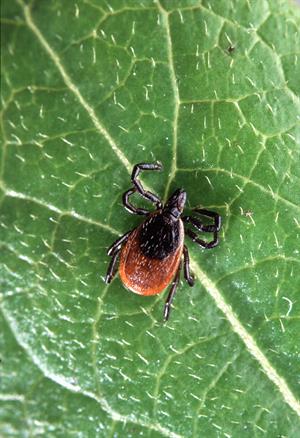 The national mindset that, with wildlife, “more is better” lingers from the early and middle 1900s when more really was better because much of our game had been depleted by market hunting. However, when wildlife is already at carrying capacity, “more” can be a disaster. Among the countless wild creatures hurt by overabundant deer are the deer themselves. Across wide expanses of their range, whitetails are sickly and scrawny.
The national mindset that, with wildlife, “more is better” lingers from the early and middle 1900s when more really was better because much of our game had been depleted by market hunting. However, when wildlife is already at carrying capacity, “more” can be a disaster. Among the countless wild creatures hurt by overabundant deer are the deer themselves. Across wide expanses of their range, whitetails are sickly and scrawny.
Birds suffer as well. The U.S. Forest Service found that when deer exceed 20 per square mile, cerulean warblers, pewees, indigo buntings, least flycatchers, and yellow-billed cuckoos can no longer survive. At 38 deer per square mile, phoebes and even robins disappear. (In his eastern project areas, DeNicola routinely deals with 100 deer per square mile.) Ground nesters, including wild turkeys, ruffed grouse, wood-cock, ovenbirds, and whippoorwills, can nest successfully in ferns. But as adults, these birds need thick cover, so they take a huge hit from predators when deer denude the understory.
Overabundant deer hurt humans, too. Each year, deer-vehicle collisions kill roughly 150 Americans and injure some 10,000 more. In suburbia, deer cause millions of dollars’ worth of damage to gardens and ornamental shrubs. Lyme disease (so named because it was discovered in Lyme, Connecticut — just a few miles east of Lord Creek Farm) is now a pandemic in the East and upper Midwest. It is transmitted by blacklegged ticks, whose abundance varies directly with the abundance of their deer hosts. In fact, evidence suggests that when deer populations are at natural densities, Lyme disease starts to fizzle out. In 2014, there were 33,461 cases of Lyme disease reported across the United States — up from about 1,500 in 1986. But the actual number was no doubt far higher because, according to the Centers for Disease Control and Prevention, 90 percent of Lyme disease cases go unreported.
At Lord Creek Farm, where Williams and his team have been eradicating barberry and conducting blacklegged-tick research (and deer density is roughly 50 animals per square mile), about 80 percent of the ticks collected from the vegetation carry the Lyme-disease bacteria.
Out of Balance
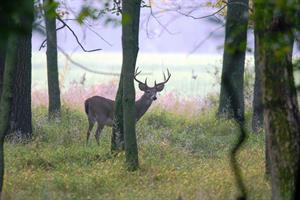 Deer overpopulate because humans have reduced or eliminated their main predators: wolves and cougars. Coyotes, bears, lynx, and bobcats will take fawns and even adult deer when they get the opportunity, but in most areas that doesn’t happen often enough to make a difference. In the early 20th century, when eastern forests started to regenerate, deer recovered. Without wolves and cougars to control their numbers and with deer-friendly landscaping available throughout suburban neighborhoods, deer populations exploded far beyond natural, healthy abundance.
Deer overpopulate because humans have reduced or eliminated their main predators: wolves and cougars. Coyotes, bears, lynx, and bobcats will take fawns and even adult deer when they get the opportunity, but in most areas that doesn’t happen often enough to make a difference. In the early 20th century, when eastern forests started to regenerate, deer recovered. Without wolves and cougars to control their numbers and with deer-friendly landscaping available throughout suburban neighborhoods, deer populations exploded far beyond natural, healthy abundance.
For example, in the 1980s, deer denuded the 2,100-acre Crane Estate — a diverse mix of salt marshes, islands, and undeveloped barrier beaches — 30 miles north of Boston. Vegetation loss was so extreme that dunes were blowing away. The property, owned by the Trustees of Reservations, was supposed to be a wildlife refuge. But about the only wildlife left were deer, with skin stretched over their ribs like canvas over Conestoga wagons.
Editorializing on the debacle, the Boston Globe reported this exchange between Bambi and his skunk pal:
“Why are you sitting?” Flower asked. “Fawns don’t sit.”
“I’m too weak to stand,” said Bambi. “I think I’ll just sit here for a few days until I fall over and die.”
And he did.
When the Trustees proposed a public hunt, it was shouted down by neighbors who eventually affected a modest and inadvertent cull of their own by feeding the starving deer cabbages, squashes, and beet greens, thereby giving them fatal cases of gastroenteritis (deer diarrhea). At this point, the area had the highest incidence of Lyme disease on the planet, and the neighbors — two-thirds of whom were infected — decided that deer hunting wasn’t cruel after all. Hunters then reduced the deer population to a healthy, natural level.
There are many areas around the country where overpopulated deer are endangering public health and destroying native ecosystems, yet residents often oppose effective control. That’s where Dr. Anthony DeNicola and White Buffalo, Inc., come in.
Repair Crew
The name White Buffalo derives from the belief of Native Americans that the birth of a white buffalo reaffirms their ties with nature. DeNicola co-founded the company in 1996 because he loved wild places and wild things and was horrified at the havoc overpopulated, hoofed mammals — especially white-tailed deer — were wreaking on native plants and animals. “I wanted people to better understand their essential connection to the land, and all that it supports, even if they live in developed environments,” DeNicola told me. “When they’re in conflict with wildlife, they are forced to deal with that connection, both positive and negative.”
Communities hire White Buffalo when deer proliferation clearly poses a danger to humans and the local economy. (Danger to wildlife is a consideration, but generally a lesser one.) White Buffalo then does an assessment and submits a management plan.
The main deer-reduction tools used by White Buffalo are crossbows and .223 rifles. If a community objects to lethal control, the company immobilizes does with tranquilizer darts and surgically sterilizes them. But this is exorbitantly expensive. Contraceptive drugs, also delivered by dart, are ineffective except where deer are essentially confined and tame.
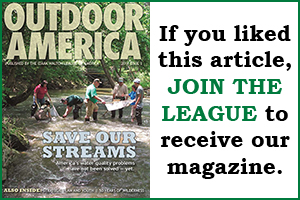 To help with culls, White Buffalo sometimes enlists deer hunters who meet its high selection standards. DeNicola likens these hunters to volunteer firemen. “They recognize the dangers of deer overabundance; they have a particular skill, and they want to help,” he says. “We’re not looking for great shots. We’re looking for fundamentals. We do interviews, background checks, and proficiency tests. A lot of it is just thinking. We have seven deer targets: four we want you to shoot at, three we don’t. If you shoot at 40 yards, you’re disqualified. If you take a quartering shot (risky in suburbia) or shoot at a fawn accompanied by a doe that is not presenting a shot [thereby teaching the doe to be elusive], you’re disqualified. If you come because you like archery and want to shoot your vertical bow [far less accurate than a crossbow], we don’t want you.”
To help with culls, White Buffalo sometimes enlists deer hunters who meet its high selection standards. DeNicola likens these hunters to volunteer firemen. “They recognize the dangers of deer overabundance; they have a particular skill, and they want to help,” he says. “We’re not looking for great shots. We’re looking for fundamentals. We do interviews, background checks, and proficiency tests. A lot of it is just thinking. We have seven deer targets: four we want you to shoot at, three we don’t. If you shoot at 40 yards, you’re disqualified. If you take a quartering shot (risky in suburbia) or shoot at a fawn accompanied by a doe that is not presenting a shot [thereby teaching the doe to be elusive], you’re disqualified. If you come because you like archery and want to shoot your vertical bow [far less accurate than a crossbow], we don’t want you.”
“Seventy to 80 percent of the hunters who come to our proficiency tests with firearms and crossbows can’t meet the standards,” continues DeNicola. “People don’t take killing an animal seriously enough. That’s why deer hunting in general has such a high crippling rate. We’ve had five volunteer programs on school grounds and private property, and we’ve killed over 100 deer with zero [crippling] loss.”
Good Try in Pennsylvania
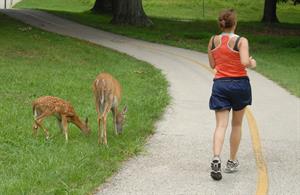 Some hunters don’t want deer culled (or even scientifically managed) because they imagine that the number of deer is directly proportional to the quality of the hunt and because they don’t grasp what too many deer do to people, wildlife, forests, and the deer themselves. In a bizarre twist, these hunters have allied themselves with animal-rights activists who don’t want any animal killed by humans for any reason.
Some hunters don’t want deer culled (or even scientifically managed) because they imagine that the number of deer is directly proportional to the quality of the hunt and because they don’t grasp what too many deer do to people, wildlife, forests, and the deer themselves. In a bizarre twist, these hunters have allied themselves with animal-rights activists who don’t want any animal killed by humans for any reason.
I asked DeNicola if all the media attention about Lyme disease and the economic and ecological damage caused by deer overabundance had changed public thinking about culls. “There’s literally no change,” he replied. “I can go into a new community, and it’s like hitting replay for the last 20 years. Exact same dynamic. Hunters aren’t happy with what we do. Animal-rights people aren’t happy with what we do. It astounds me. It’s the same exercise, the same protracted process every time. Either a community has leadership that drives the decision [to cull] or the community flounders. When we finish a project, attitudes are the same as well — people are always astonished by the benefits [of fewer deer].”
These benefits started to become visible across Pennsylvania after Dr. Gary Alt, a renowned black bear biologist, took over the state Game Commission’s deer program in 1999. By drastically extending antlerless seasons with increased doe tag allocations so that more does were harvested, he was able to significantly reduce deer numbers and create a more natural buck-doe ratio. Killing just bucks doesn’t help much in reducing overabundant deer because you can deplete the buck population by 95 percent, and the 5 percent that survive will impregnate most of the does.
Under Alt’s leadership, Pennsylvania made the first real progress in balancing deer to habitat on a state level. Through an intensive education campaign, Alt helped hunters recognize the benefits of scientific deer management. The Izaak Walton League presented Alt with an Honor Roll Award for his exemplary conservation efforts. The Quality Deer Management Association named him “Professional Deer Manager of the Year.” Safari Club International gave him its Conservation Award. Outdoor Life magazine gave him its Public Service Conservation Award. The Pennsylvania Wildlife Federation gave him its Outstanding Conservation Professional Award and (along with Audubon Pennsylvania) named him Conservation Educator of the Year.
Still, after six years, Alt resigned from the Pennsylvania Game Commission — a decision he attributes to political interference that intimidated his superiors to the point that his team couldn’t do its job. “The history of deer management,” he told me, “is full of a very small proportion of tenacious, highly motivated hunters driving the system. They oppose antlerless harvest and extended seasons. And they know exactly who to contact.” The politicians then hold the agencies hostage, threatening to nix important legislation or license fee increases unless managers cater to the more-is-better crowd.
Williams and DeNicola well know what Alt is talking about. In Redding, Connecticut, they initiated an experiment (funded by the Centers for Disease Control and Prevention) to see if balancing deer with habitat could break the Lyme-disease cycle. In two one-square-mile study areas, they planned to reduce overpopulated, tick-riddled deer to a healthy and natural 8 to 10 animals per square mile, at which point the literature indicated that ticks might peter out for lack of hosts.
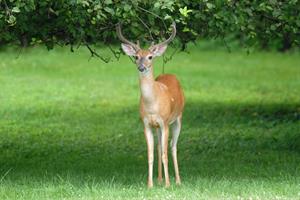 But a handful of local hunters calling themselves the Redding Sportsmen’s Alliance whipped the community and politicians into a froth of panic and paranoia over a supposed reduction in hunting opportunities. In widely circulated letters, the Alliance falsely charged that White Buffalo and the Connecticut Agricultural Experiment Station, both of which had sought and acquired all necessary permits, “have broken a number of state and federal laws in the Town of Redding, and now the public and the state of Connecticut need to hold them accountable.” Equally fictitious accusations appeared almost daily on Web sites or in newspaper ads.
But a handful of local hunters calling themselves the Redding Sportsmen’s Alliance whipped the community and politicians into a froth of panic and paranoia over a supposed reduction in hunting opportunities. In widely circulated letters, the Alliance falsely charged that White Buffalo and the Connecticut Agricultural Experiment Station, both of which had sought and acquired all necessary permits, “have broken a number of state and federal laws in the Town of Redding, and now the public and the state of Connecticut need to hold them accountable.” Equally fictitious accusations appeared almost daily on Web sites or in newspaper ads.
After Williams and his team counted 45 deer per square mile from a helicopter flying 20 miles per hour at 200 feet, the Redding Sportsmen’s Alliance proclaimed the figure was “mathematically impossible” because some of its members had observed only 2 deer per square mile — from a Cessna flying 120 miles per hour at 500 feet. “One Alliance member,” Williams says, “revealed that he put on night-vision goggles and body armor and sat next to the shooting site to ‘keep an eye on White Buffalo.’ Another was following us around, videotaping. Someone was going to get hurt, so I pulled the plug.” Although White Buffalo had removed 87 deer over 3 years, that didn’t reduce the population to anywhere near the target of 8 to 10 animals per square mile. All the effort and grant money was wasted.
Hunters who oppose sharpshooting culls in suburbia argue that they can do the job themselves. But White Buffalo is permitted to shoot at night with silencers and infrared thermal-imaging equipment and in crowded neighborhoods — something recreational hunters can’t do. And White Buffalo is permitted to set up bait stations, something recreational hunters can rarely do. Multiple studies demonstrate the inefficiency of recreational hunting in suburbia. In a piece Williams and DeNicola co-authored for the Wildlife Society Bulletin and in which they cite some of their own research, they write: “In most cases, hunters have limited access, legal restrictions (i.e., firearm discharge limitations), or may not prefer to see deer densities reduced below a level of recreational interest…. Deer subjected to such efforts become educated and may behave differently during removal, and surviving deer may alter behaviors, potentially limiting efficacy of future removal efforts (Williams et al., 2008). There appears to be a threshold where hunters can no longer reduce deer densities because deer become too elusive.”
What about the situation outside the suburbs? When I asked DeNicola if there are enough hunters to bring deer into balance with habitat at the county or state levels, he said, “I think there are enough hunters. What it comes down to is the interest in having elevated deer densities. That’s the biggest obstacle to effective management. I think hunters have become spoiled over the last several decades, where state agencies were excessively conservative with antlerless permits. There are these 10- or 15-year cycles. The population crashes because of a harsh winter. The state agency gets blamed. Hunters want more deer. The population rebounds. Hunters are happy; they think somehow these densities can be sustained. The population crashes again. The agencies have no clout because there’s usually a political body that oversees the biologists. Then the politicians wonder why there’s no forest regeneration.” He cited Alt’s experience in Pennsylvania as Exhibit A.
The Solution
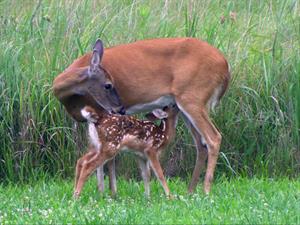 “The greatest mistake ever made in wildlife management” is how Alt defines allowing deer to overpopulate to the point they destroy the ecosystem they’re part of. For a while, it looked like he would permanently correct that mistake in Pennsylvania. When Alt inherited the deer program, the state had the most unhealthy buck-doe ratio in the United States. Ninety percent of harvested bucks had left their mothers only six months earlier. “We were exterminating them as soon as they grew antlers,” Alt says. During his tenure, antlerless harvest was the highest by far in the state’s history.
“The greatest mistake ever made in wildlife management” is how Alt defines allowing deer to overpopulate to the point they destroy the ecosystem they’re part of. For a while, it looked like he would permanently correct that mistake in Pennsylvania. When Alt inherited the deer program, the state had the most unhealthy buck-doe ratio in the United States. Ninety percent of harvested bucks had left their mothers only six months earlier. “We were exterminating them as soon as they grew antlers,” Alt says. During his tenure, antlerless harvest was the highest by far in the state’s history.
And it began to work. “Even when you start shooting half a million deer a year like we did, it takes a while for that to be measurable on a forest ecosystem,” explains Alt. “The numbers are so high you’ve got to grind them down, and then they have to be down a while before the plants respond. It wasn’t until about three years ago that we started to see major improvements. We’ve got a generation of trees past the deer for the first time in decades.”
But the “sad news,” Alt says, “is that the Game Commission has been taking more and more bricks out of the wall. The real killer is that they’ve pretty much gutted the concurrent buck and doe season [with its heavy emphasis on antlerless harvest]. Even though the bucks-only faction is a tiny percent of the sportsmen, they’re effective. They pressure the agency through their legislators.”
By no means is the Pennsylvania situation an anomaly. “A lot of states are like that,” declares Kip Adams, senior wildlife biologist at the Quality Deer Management Association. “In my 20-plus years as a wildlife biologist, science has never meant less than it does today.”
Pennsylvania now has the highest number of deer-vehicle collisions in the nation. Some towns are taking matters into their own hands. In an effort to reduce collisions by 50 percent over the next five years, the Pittsburgh suburb of Mt. Lebanon has hired White Buffalo to conduct archery and sharpshooting culls.
The archery cull began September 19 and continued through January. The sharpshooting cull runs from February 1 to March 1.
If you live in an area with too many deer and really want to help wildlife (deer included), get involved at the state level in support of science-based wildlife management. Write letters to the editor of your local newspaper. Attend hearings. Educate your fellow hunters. Urge your fish and wildlife agency to base all management decisions on science provided by the wildlife professionals you and your fellow sportsmen help hire through license fees and the taxes you pay on guns, archery equipment, and ammunition. Stand tall against voices of the past that insist on the failed, dangerous practice of bucks-only harvest.
Support our work for wildlife conservation